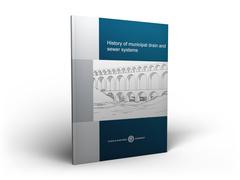
|
|
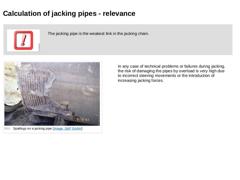
|

|
(Image: Attention!)
The jacking pipe is the weakest link in the jacking chain. |
(Image: Spallings on a jacking pipe) In any case of technical problems or failures during jacking, the risk of damaging the pipes by overload is very high due to incorrect steering movements or the introduction of increasing jacking forces. |
|
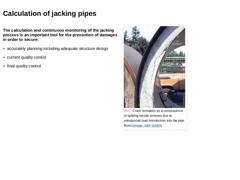
|

The calculation and continuous monitoring of the jacking process is an important tool for the prevention of damages in order to secure: (Image: Crack formation as a consequence of splitting tensile stresses due to unbalanced load introduction into the pipe faces) |
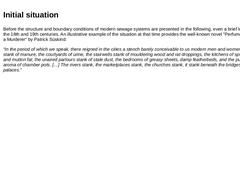
|
Before the structure and boundary conditions of modern sewage systems are presented in the following, even a brief look back into the 18th and 19th centuries. An illustrative example of the situation at that time provides the well-known novel "Perfume. The story of a Murderer“ by Patrick Süskind: “In the period of which we speak, there reigned in the cities a stench barely conceivable to us modern men and women. The streets stank of manure, the courtyards … |

|
(Image: Contemporary copper engraving of the Plague of Marseille of 1720) (Image: A Portrayal of Cholera from 1912) These were the living conditions in many places until far into the 19th century. It was the third largest cholera epidemic of 1863, which convinced the last sceptics of the necessity to significantly improve the hygienic conditions in the cities to safeguard the survival of the remaining population. |
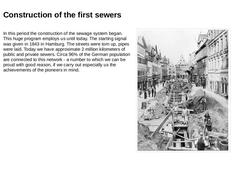
|
In this period the construction of the sewage system began. This huge program employs us until today. The starting signal was given in 1843 in Hamburg. The streets were torn up, pipes were laid. Today we have approximate 2 million kilometers of public and private sewers. Circa 96% of the German population are connected to this network - a number to which we can be proud with good reason, if we carry out especially us the achievements of the pioneers … |
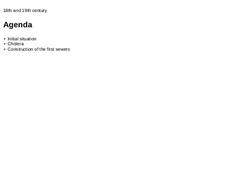
|
|

|
This lesson continues in the form of a script. Please take all further information from the script „History of municipal drain and sewer systems“. |

|
|

|
Congratulations! You have successfully finished the first part of the lesson. The lesson continues in the form of a script. Please take all further information from the following script “History of municipal drain and sewer systems”. Stay curious! |
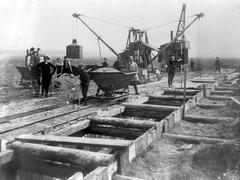
|
This module provides an overview of the historical development of water supply and sanitation and their meaning cultural development of mankind. After completing this module, you will have knowledge regarding: - principal eras and
- their contribution to the sanitary development.
|
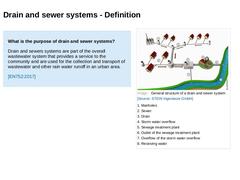
|
What is the purpose of drain and sewer systems? Drain and sewers systems are part of the overall wastewater system that provides a service to the community and are used for the collection and transport of wastewater and other rain water runoff in an urban area. [EN752:2017] (Image: General structure of a drain and sewer system) |
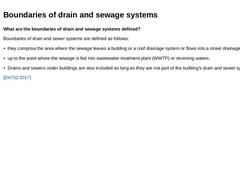
|
What are the boundaries of drain and sewage systems defined? Boundaries of drain and sewer systems are defined as follows: -
they comprise the area where the sewage leaves a building or a roof drainage system or flows into a street drainage system
-
up to the point where the sewage is fed into wastewater treatment plant (WWTP) or receiving waters.
-
Drains and sewers under buildings are also included as long as they are not part of the building’s drain …
|
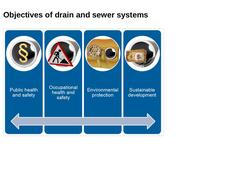
|
(Image: Objectives of drain and sewer systems) Relevant objectives of drain and sewer systems must focus on: -
Public health and safety
-
Occupational health and safety
-
Environmental protection and
-
Sustainable development
|
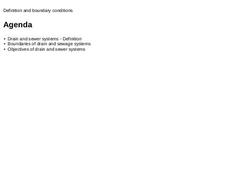
|
|
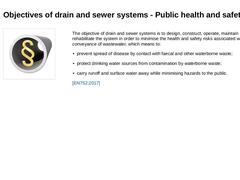
|
The objective of drain and sewer systems is to design, construct, operate, maintain and rehabilitate the system in order to minimise the health and safety risks associated with the conveyance of wastewater, which means to: -
prevent spread of disease by contact with faecal and other waterborne waste;
-
protect drinking water sources from contamination by waterborne waste;
-
carry runoff and surface water away while minimising …
|
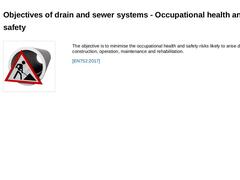
|
(Image: Icon: Construction site) The objective is to minimise the occupational health and safety risks likely to arise during construction, operation, maintenance and rehabilitation. [EN752:2017] (Image: Inspection of an accessible sewer - Protective equipment) (Image: Inspection of an accessible sewer) (Image: Danger of collapse of a sewer - Health and safety of the operating personnel is endangered) |
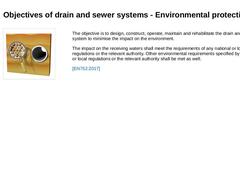
|
(Image: Icon: Soil investigation) The objective is to design, construct, operate, maintain and rehabilitate the drain and sewer system to minimise the impact on the environment. The impact on the receiving waters shall meet the requirements of any national or local regulations or the relevant authority. Other environmental requirements specified by any national or local regulations or the relevant authority shall be met as well. [EN752:2017] (Image: … |
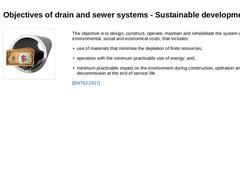
|
The objective is to design, construct, operate, maintain and rehabilitate the system at the best environmental, social and economical costs, that includes: -
use of materials that minimise the depletion of finite resources;
-
operation with the minimum practicable use of energy; and,
-
minimum practicable impact on the environment during construction, operation and decommission at the end of service life.
[EN752:2017] |
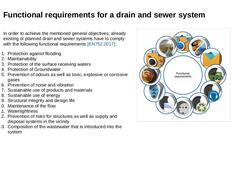
|
In order to achieve the mentioned general objectives, already existing or planned drain and sewer systems have to comply with the following functional requirements [EN752:2017]: -
Protection against flooding
-
Maintainability
-
Protection of the surface receiving waters
-
Protection of Groundwater
-
Prevention of odours as well as toxic, explosive or corrosive gases
-
Prevention of noise and vibration
-
Sustainable use of products and materials
-
Sustainable …
|
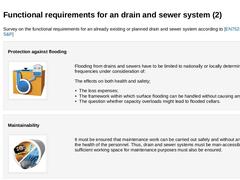
|
Survey on the functional requirements for an already existing or planned drain and sewer system according to [EN752:2017] [FI-S&P] Protection against flooding (Image: Icon: Protection against flooding) Flooding from drains and sewers have to be limited to nationally or locally determined frequencies under consideration of: The effects on both health and safety; -
The loss expenses;
-
The framework within which surface flooding can be handled without causing …
|
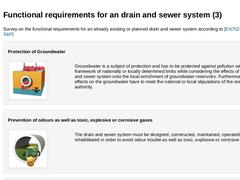
|
Survey on the functional requirements for an already existing or planned drain and sewer system according to [EN752:2008] [FI-S&P] Protection of Groundwater (Image: Icon: Protection of groundwater) Groundwater is a subject of protection and has to be protected against pollution within the framework of nationally or locally determined limits while considering the effects of the drain and sewer system onto the local enrichment of groundwater reservoirs. … |
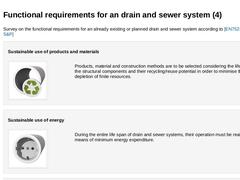
|
Survey on the functional requirements for an already existing or planned drain and sewer system according to [EN752:2017] [FI-S&P] Sustainable use of products and materials (Image: Icon: Sustainable use of products and materials) Products, material and construction methods are to be selected considering the life span of the structural components and their recycling/reuse potential in order to minimise the depletion of finite resources. |
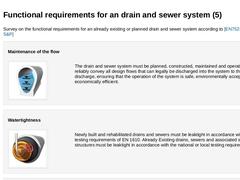
|
Survey on the functional requirements for an already existing or planned drain and sewer system according to [EN752:2017] [FI-S&P] Maintenance of the flow (Image: Icon: Maintenance of the flow) The drain and sewer system must be planned, constructed, maintained and operated to reliably convey all design flows that can legally be discharged into the system to the point of discharge, ensuring that the operation of the system is safe, environmentally acceptable … |
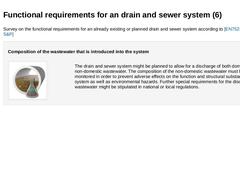
|
Survey on the functional requirements for an already existing or planned drain and sewer system according to [EN752:2017] [FI-S&P] Composition of the wastewater that is introduced into the system (Image: Icon: Composition of the wastewater that is introduced into the system) The drain and sewer system might be planned to allow for a discharge of both domestic and non-domestic wastewater. The composition of the non-domestic wastewater must be monitored … |